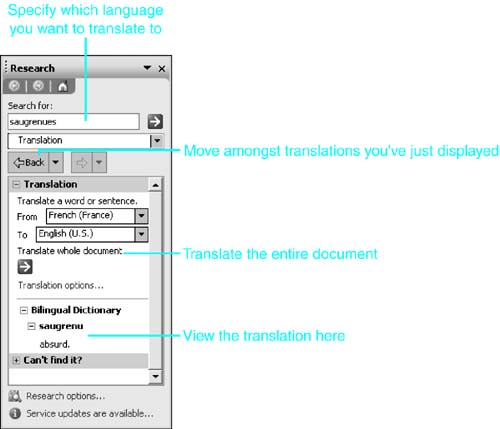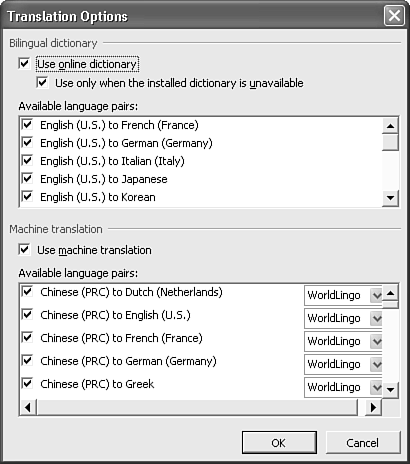Using Word's Built-In Language Translation Tools
Word can translate words among any languages for which it has access to a bilingual dictionary. Word 2003 can also draw on Web-based machine translation services for language pairs that are not already installed on your computer, if you are connected to the Internet. These translation services are provided by WorldLingo, a leading provider of both machine-based and human translation services. |
By default, Word begins with the bilingual dictionaries it finds on your computer; then if no results are returned, it attempts to retrieve results from WorldLingo's Web-based services. If you select more than one word for translation?for example, an entire sentence or document?Word will rely on WorldLingo.
Office 2003 can translate words between the following language pairs:
English (U.S.) and French (France)
English (U.S.) and German (Germany)
English (U.S.) and Italian (Italy)
English (U.S.) and Spanish (Spain-Modern Sort)
English (U.S.) and Japanese
English (U.S.) and Korean
English (U.S.) and Chinese (both People's Republic of China and Taiwan variants)
When machine translation is turned on, several additional languages are available through WorldLingo, including Russian, Dutch, Portuguese, and Greek. With machine translation, you can also translate among non-English languages; for example, directly from French to Greek.
To translate text, select it; right-click to display the shortcut menu, and choose Translate. The Research task pane opens, with the word's translation from English to French (see Figure 8.16).
Figure 8.16. Word's Research task pane displaying a translation to French.

TIP
To translate a single word, you can also press the Alt key and then click on the word.
NOTE
For the first time, translation services are available throughout Microsoft Office, not just in Word. In Office 2003, the same translation capabilities are accessible through Excel, OneNote, Outlook, PowerPoint, Publisher, Visio, and Internet Explorer.
NOTE
If Translation features are not available, Word may present an error message asking whether you want to install them. Click Yes to do so. You will need access either to your Word or Office CD-ROM, or to the network location you installed Word or Office from.
To translate into a different language, choose the language from the To drop-down box.
To copy the translated text into your document, select it within the task pane, using Word's selection tools. For example, to select a word, double-click on it; to select a paragraph, triple-click on it. Next, right-click, and choose Copy from the shortcut menu.
As with the Thesaurus feature discussed earlier in this chapter, you can use the Back and Forward buttons to move among translations you've just displayed (refer to Figure 8.14).
Controlling Translation Options
To control how the Translation feature works and whether it uses Web-based resources, click Translation Options on the Research task pane. The Translation Options dialog box opens (see Figure 8.17). |
Figure 8.17. Controlling translation options.

By default, Word uses all the resources available to it: its own built-in bilingual dictionaries, WebLingo's online dictionaries when no dictionary is installed, and WebLingo's machine translation services.
You can specify which resources Word utilizes. For example, if you prefer not to access the Internet for translation services of any kind, you can clear the Use Online Dictionary and Use Machine Translation check boxes.
Conversely, if you'd like to see what WorldLingo can come up with even if Word is capable of translating from its own built-in French or Spanish dictionaries, clear the Use Only When the Installed Dictionary is Unavailable check box.
Translating Entire Documents
You can translate an entire document using Word's Web-based machine translation services. The resulting translation appears in an Internet Explorer window. |
To translate an entire document, display the Translation task pane (for example, right-click in the document and click Translate, or choose Tools, Language, Translate). Then, click the large green arrow under Translate Whole Document.
It may take a little while for your translation to appear, depending on its length and the speed of your Internet connection. When it is displayed, WorldLingo and MSN provide a quote and link that allow you to purchase a more refined translation by a human translator (see Figure 8.18).
Figure 8.18. Translating an entire document using WorldLingo's translation services.








